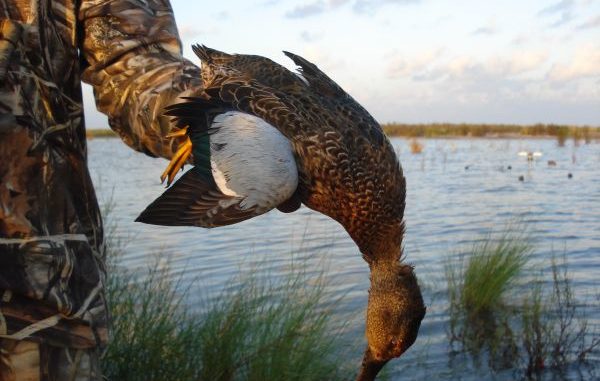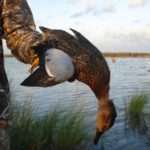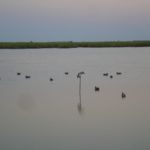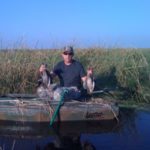
It doesn’t take migrating ducks long to be educated by blinds sticking up out of Louisiana’s marshes, but they just don’t seem phased by layout boats.
You hear it all the time when it comes to duck blind concealment: Low profile is key.
After all, the marshes of South Louisiana aren’t exactly known for stands of trees providing habitat conducive to hiding. Our marshes are dominated by cord grasses standing a towering 2 or 3 feet above the muck, depending on when the last hurricane visited.
If you’re lucky, there might be a patch of Roseau cane near your favorite pond, but that is usually more exception than norm.
And it seems that birds most often use ponds that inconveniently offer minimal cover to the hunter in pursuit.
That said, I have to chuckle when chasing summer redfish in the marsh and I come across blind after blind towering over the surrounding landscape. You know the ones I’m referring to: Just look out the window on your next flight out of Louis Armstrong New Orleans International.
Most “blinds” are readily identifiable across the marshlands from the air, even when all dressed up in their hunting-season best.
Don’t get me wrong: These structures are great for those hunters wanting at least a couple of creature comforts while out on the hunt. Most feature bench seating and shelves for your gear, with usually just enough cover material to break the occasional chilly wind.
The blinds are stout, with ornate supporting framework that was undoubtedly nothing short of hellacious to construct while baking in the late summer sun. Marshland engineering is at its finest in some of the lengths our resourceful coastal hunters have gone to put their permanent behemoth in just the right orientation to catch those teal from the direction they seem to always come from.
As a side note, this direction will always be your blind side, no matter the vigilant preparations, provided you can even convince the birds that it’s safe to venture anywhere near said behemoth.
One hunter who has taken a “get low” approach and found the birds to be correspondingly cooperative is Johnny LaFleur, sales manager of Boat City USA in Hammond.
LaFleur’s success on a number of Southeast Louisiana public waters comes as a result of attention to detail in all facets of the hunt, though he takes particular care to best utilize the meager height of the surrounding marsh grass in his favor.
To that point, a couple of years back LaFleur ditched the traditional tried-and-true Louisiana pirogue in favor of two layout boats.
Following discussions with a local manufacturer at the Louisiana Sportsman Show a few years back, LaFleur was convinced that making the change was going to put more birds on the strap and add convenience to each hunt. And from the results that followed, it doesn’t look like he’s turning back any time soon.
LaFleur’s go-to marsh vehicle is the Layflat by HydroFlat Boat of Kenner.
These boats are designed to blend into any type of habitat, and are particularly useful for hiding in our coastal marshes.
Able to be paddled or poled, these small craft have proven more than serviceable for this type of hunting — in fact, downright effective.
“The stability of the little boats really impressed me,” LaFleur said. “I can kneel on the side of it and it won’t roll over.
“There’s even a small platform on the back of it where a dog could sit or you can load extra gear.”
Factor in the optional spud-pole slots and the versatility of the boats is truly realized, considering how many different ways you can set up in them.
In LaFleur’s realm, low profile means less than 2 feet in overall height above the water at any given time — and actually much lower when in full-concealment mode while working approaching flocks from the cozy confines within.
Sporting an overall length of 10 feet and measuring about 3 feet at its widest point, the boats are well suited to riding in the back of a truck for quick roadside deployment and can be shuttled deeper in the marsh within a flat boat.
“At only 10 feet long, I can spin this boat around within its own radius, so it makes navigating in tight quarters a breeze,” LaFleur said.
Despite the convenience of having an all-in-one blind, however, it was ultimately the ease of concealment that sold LaFleur on making the switch.
Like most public lands, there’s plenty of pressure on the Southeast Louisiana public marshes LaFleur frequents.
“These birds see a pile of decoys in every other pond and two heads sticking up from the grass watching them on every other point,” he quipped.
His ability to set up on or near the smallest of islands gives him the upper hand when other hunters are reliant upon enough landmass to hide themselves and their gear.
“The layout boats allow me to set up right against the bank, using the shoreline to help me blend in,” LaFleur explained. “We don’t even have to get out the boats while setting up. From tossing decoys to retrieving birds, we do it all from the layout boats.
“You can even hunt in your slippers.”
Decoys can be hauled either on top of the boat or within the hull, along with a gun and shell bag. Though the little boats are inherently not the most storage-friendly of rigs, there’s just enough room for one hunter’s necessities.
Another significant advantage to the layout boats is their ability to pose as their own island when set up in the middle of larger ponds.
“A lot of times I’ll find the birds to be trafficking consistently over a particular pond with no land big enough for a traditional setup,” LaFleur said. “We simply paddle out there and surround ourselves in decoys, putting ourselves right on the honey hole using the spud poles.
“There’s no point in fighting them; instead, we just put ourselves right where they already want to be.”
When the regular season rolls around, this tactic becomes even more effective, as birds begin to raft in larger waters after being educated by the marsh grass shooting at them.
Just as many folks have discovered the effectiveness of setting up in boat blinds in the middle of large ponds late in the season, the layouts prove even more effective because they’re a much less intrusive presence with a lot less “boat” to hide.
Despite lacking the traditional comforts of permanent blinds, the layouts offer a different type of comfort many find perhaps too relaxing at times.
“For better or worse, it’s easy to take a nap in these boats when the flights get slow or when you’re set up well before shooting time,” LaFleur pointed out.
Like many public-land warriors, LaFleur arrives in the marsh long before sunrise to make sure he’s able to set up right where the birds have been trafficking.
“Once the decoys are out and I’m in position, its nap time until shooting time rolls around — and these boats are a whole lot more comfortable than a pirogue or flat boat to lie down in.”
Though they may generate some funny looks at the launch on your next trip, the effectiveness of layout-boat hunting often speaks for itself with hefty straps. The little boats simply allow for optimal concealment in nearly any situation a hunter might face.
If one can adapt a strategy to accommodate the minor shortcomings, the boats’ ability to hide in plain sight can be a game-changer when birds become wary of land and the traditional blinds they often host.
Starting this month with blue-winged teal and winding all through the end of January, you’ll find LaFleur literally lying in wait and ambushing those birds that have avoided the assortment of “blinds” throughout our coastal marshes.






